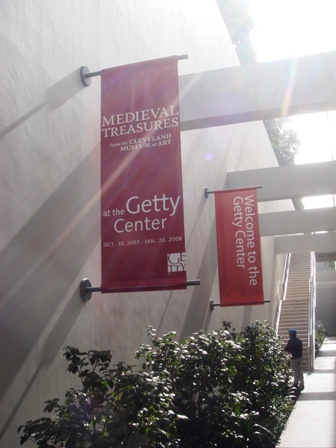
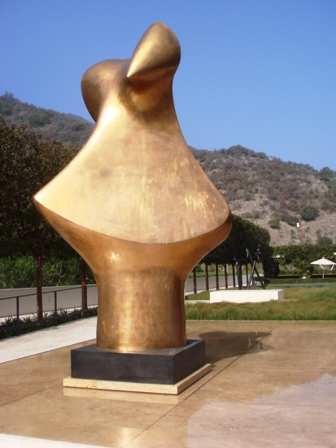
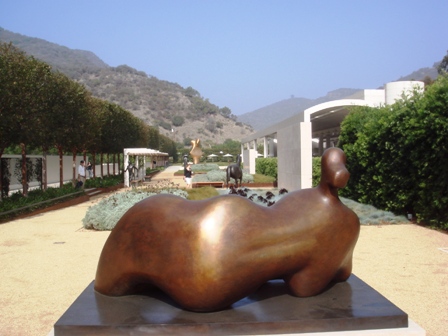

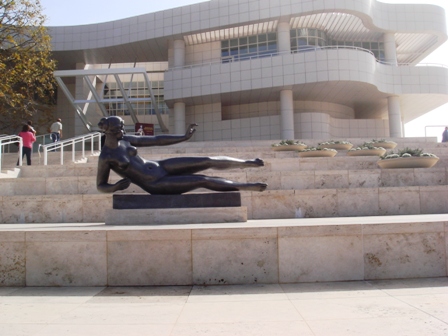
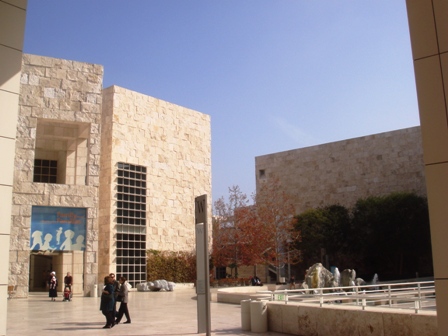
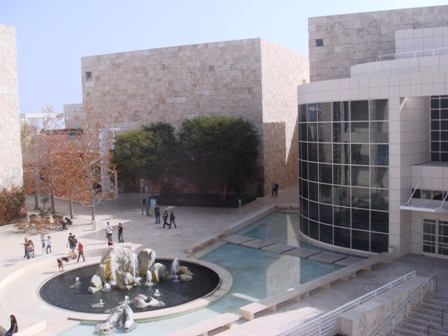

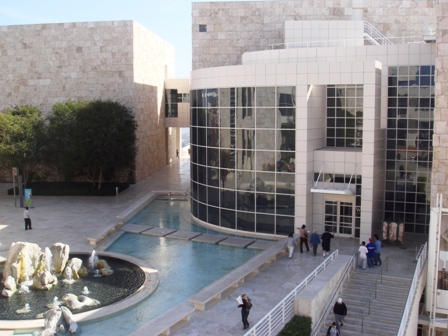

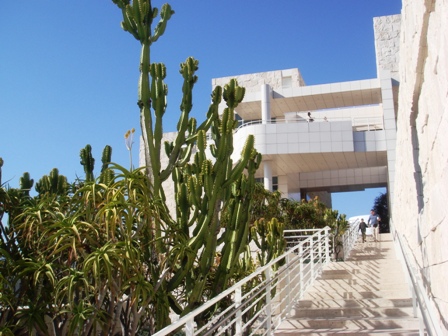
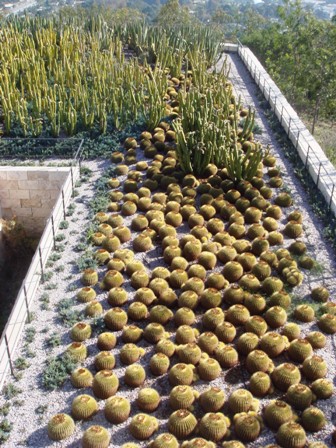
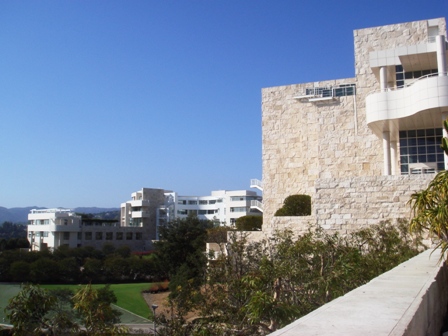
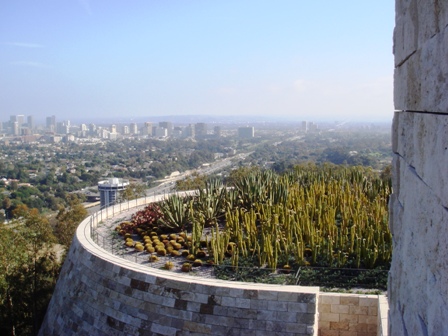
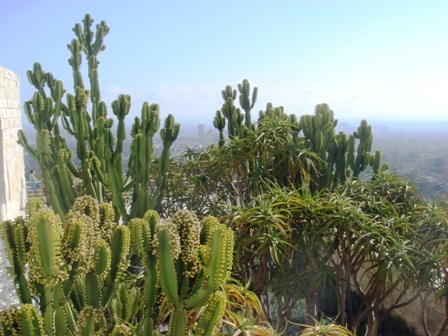
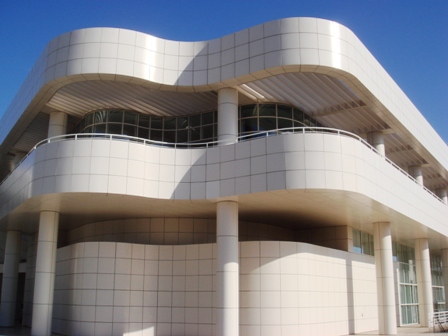
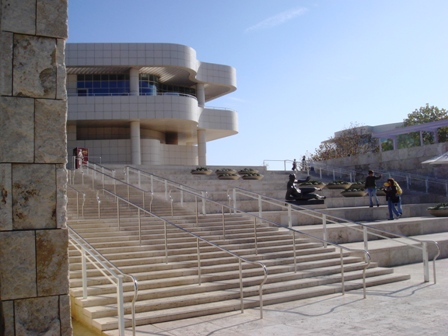
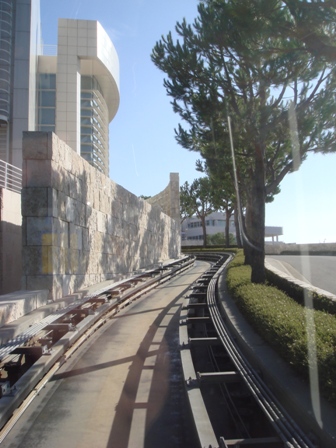
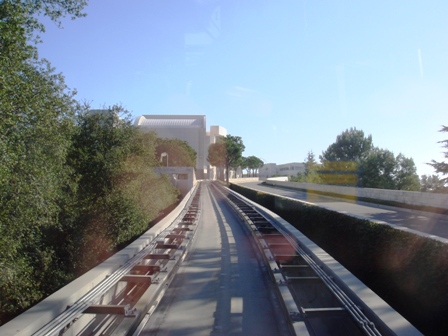
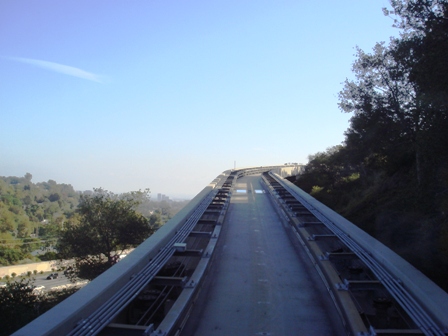
It is impossible to take pictures from inside the museum, but the general situation of this museum is impressive.




















It is impossible to take pictures from inside the museum, but the general situation of this museum is impressive.
Après ces merveilleuses dégustations, un peu de repos s’impose. Faire du shopping à Beverly Hills, c’est imaginer, l’espace d’un instant que l’on est riche. Les articles que je regarde ont un nombre suffisant de zéros avant la virgule pour que je me tienne sage, sauf pour des vêtements qui font de moi un « vrai » américain. Je vais au musée Getty. Comment est-il possible, même pour l’homme qui fut le plus riche du monde, d’acheter une immense colline qui offre une vue époustouflante sur Los Angeles et d’y construire une ensemble gigantesque qui représente au moins cent fois la villa Noailles de Hyères. Les parkings en sous-sol pour les bus scolaires couvrent des hectares. On accède au site par une noria de navettes électriques qui sont les mêmes qu’aux nouveaux terminaux de Roissy et l’on est accueilli par une splendide sculpture de Maillol qui fait une tache de couleur devant un ensemble de bâtiments en marbre blanc. Alentour on peut discerner à travers le brouillard constant des panoramas à couper le souffle. La comparaison à la villa Noailles n’est pas vide de sens tant l’enchevêtrement de bâtiments et de perspectives ouvre des horizons nouveaux.
Je vais visiter une exposition temporaire d’œuvres médiévales, et j’ai un choc qui crée un lien avec le monde du vin. Des sculptures en marbre du 4ème siècle, des tapisseries brodées aux couleurs vives du 5ème siècle, de fines gravures sur ivoire du 8ème siècle montrent que cette époque que l’on voudrait considérer comme barbare avait un sens artistique et une virtuosité technique qui n’a rien à envier à la Renaissance postérieure parfois de mille ans. Je vois une petite plaque octogonale en or avec le Christ crucifié au centre, entouré de douze têtes qui émergent de la plaque, représentant les apôtres aux visages précis malgré leur taille minuscule. Un tel travail d’orfèvrerie ne peut se concevoir dans un monde barbare. Des centaines d’objets remarquables d’une période s’étendant de l’an 300 à 1450 montrent un savoir faire, surtout sur l’ivoire et les enluminures qui me semble perdu aujourd’hui faute de temps et de mécènes. Le lien avec le vin est le suivant : du fait d’une industrialisation extrêmement rapide qui modifie le champ conceptuel presque tous les dix ans, nous croyons bien trop facilement que le monde a été inventé lorsque nous sommes nés et que les générations qui nous précèdent vivaient dans un obscurantisme total. Voilà qu’une tapisserie bien conservée tissée il y a 1600 ans rappelle qu’on savait créer avec art il y a très longtemps, qu’un ivoire d’une émotion intense montre qu’il y a 1200 ans, on créait avec délicatesse. Trop de gens estiment que le bon vin a été inventé dans les quarante dernières années. Ils oublient que la tradition orale, qui permettait la transmission de génération en génération des secrets de l’orfèvrerie a joué le même rôle pour l’excellence du vin. Il y a cent ans, on savait faire du vin, avec l’acquis de plus de mille ans d’essais et d’erreurs. Le vin ne date pas de l’arrivée des maîtres à penser d’aujourd’hui. Le choc artistique qu’a occasionné cette merveilleuse exposition dépasse – fort heureusement – la seule pensée de la similitude au vin. Le musée Getty est un lieu où il faut impérativement se rendre.
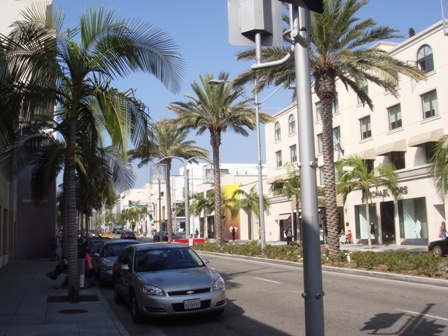
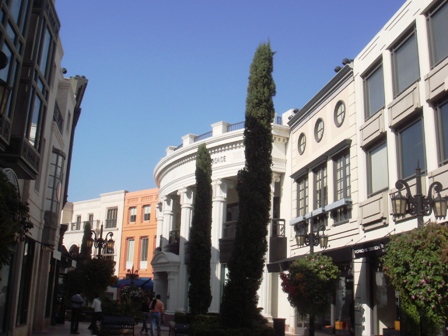
Rodeo Street is designed to make a rodeo with your bank account.
How much time will it stay on its saddle ?
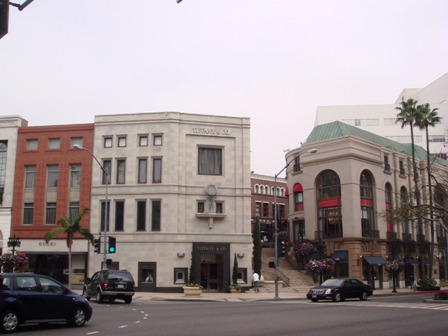
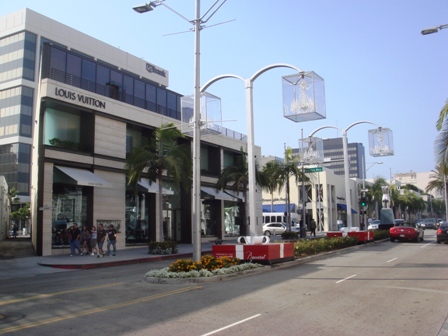
Tiffany, Louis Vuitton, and in the middle of the street, pacakaging of Baccarat.
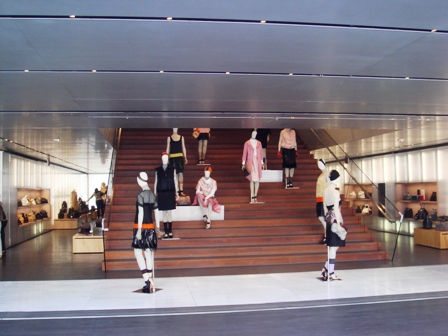
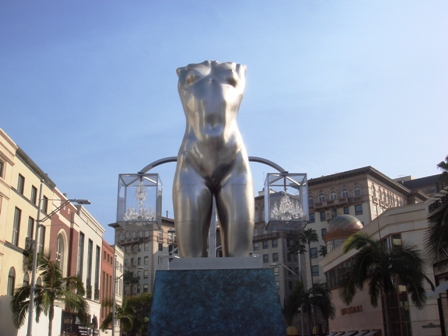
This shop has no window, no barrier, and this naked woman in the middle of the street suggests : "buy me clothes".
All in the town perspires luxe, success.
Not bad !
Après un petit break suivant le déjeuner avec les plus grands Cheval Blanc, nous nous retrouvons à nouveau pour le premier repas consacré à Yquem, un dîner à Chinois on Main, avec la cuisine de Luis Diaz et René Mata, et avec la supervision des vins de Christian Navarro. La dégustation est conduite par Bipin Desai et l’invité d’honneur est Pierre Lurton, qui va nous donner des informations très précises sur chaque année avec les dates de vendanges, les rendements, les taux d’alcool, d’acidité et de sucre potentiel ou résiduel. Je suis arrivé très en avance de mon hôtel, aussi je peux voir toutes les bouteilles dorées alignées sous la bienveillante protection d’un Bouddha, dont l’énigmatique visage semble indiquer qu’une telle offrande est acceptable par Lui.
Le menu se compose de : passed hors d’oeuvre / Pithivier of stir-fried squab with roasted sweet potato puree / Santa Barbara prawns on sweet and sour beets with sesame seed and plum wine emulsion / roasted Kurobota pork loin with slow braised shoulder, dry apricots and toasted almond / upside down passion fruit cheesecake with pineapple sabayon.
Si l’on excepte le porc, je n’ai pas été impressionné par les essais d’accords avec Yquem, qui peuvent être largement meilleurs comme nous le verrons demain. Mais l’endroit est si charmant et le staff est si actif que nous avons passé un très beau moment.
Voici une anecdote qui m’a fait sourire. Quand je fais des dîners avec des grands chefs pour mettre en valeur des vins anciens, je leur demande de simplifier leur cuisine, en leur disant qu’une cuisine simplifiée peut être délicate et montrer aussi bien leur talent. Quand le « pork loin » arrive sur la table, il y a sur l’assiette seulement trois tranches de viande, sans sauce, sans aucun extra. Et je me mets à penser : “wow, ils ont compris ce qu’il faut pour Yquem”. Et soudain, un serveur arrive avec une énorme cocotte et remplit les assiettes avec une autre viande (l’épaule), des légumes et de la sauce. J’avais rapidement essayé la viande seule avec l’Yquem, juste pour vérifier que ça marche bien. Le plat plus complexe est trop lourd pour être un véritable ami d’Yquem.
La première série : Yquem 2003, 2000, 1998, 1995, 1982, 1970
L’examen des odeurs n’est pas d’un grand secours pour ces jeunes vins. J’ai juste noté que le plus grand nez est celui du 1970, ce qui est normal car c’est le plus vieux. Le 2003 a pris du corps depuis que je l’ai goûté au château. J’y vois de la figue, du fruit tropical, des gâteaux exotiques. Le vin est opulent, avec du gras. C’est réellement un grand vin.
Le 2000 est plus élégant, plus discret, mais le sucre se montre plus. C’est un Yquem moins intéressant. Le 1998 est nettement plus léger. Un Yquem plus limité qui ne m’a jamais vraiment convaincu. Il n’a pas la personnalité que les autres peuvent montrer. Le 1995 qu’Alexandre de Lur Saluces complimenta beaucoup à sa première apparition est élégant, mais je le trouve trop monolithique, trop simple. Le 1970 est maintenant sur mes lèvres : ça, c’est un vin ! Le sucre est très limité ; élégance, douceur et charme sont là. Ce n’est probablement pas le plus imaginatif, mais j’aime son côté aérien en bouche et son goût d’abricot. Le 1982 a une très belle attaque de citron vert. Il a équilibre, structure, sérénité. C’est typiquement un vin de gastronomie.
Mon classement : 1982 – 2003 – 1970 – 2000 – 1995 – 1998.
Le classement en considérant le potentiel mettrait le 2003 au dessus du 1982.
Seconde série : Yquem 1986, 1961, 1953.
Les couleurs des deux plus vieux sont fantastiques. C’est ce à quoi Yquem devrait ressembler. Le 1986 est légèrement amer, mais avec le temps, il gagne en élégance. Ce vin a été une « sleeping beauty » pendant longtemps. Il est très probable qu’il va connaître un développement positif. Avec le 1961 nous entrons dans une nouvelle génération d’Yquem. Ce vin a de l’équilibre, mais plus que cela, une aisance à la George Clooney. Il est dans une phase « mangue ». Le 1953 est complètement féminin. Contrairement aux vins qui réclament un plat, ce 1953 a un tel charme en douceur qu’il devrait être bu seul, pour en apprécier la subtilité.
Pierre Lurton trouve que le 1961 a un final plutôt amer, mais en fait ce vin abandonne progressivement son sucre et devient plus sec, comme cela arrive plus fréquemment pour la décennie 30.
Goûtant de nouveau les vins je trouve que le 1986 irait très bien avec un homard, et même si le final n’est pas le plus spectaculaire, je le trouve plaisant. Le 1961 prend des notes de thé, s’assèche un peu mais c’est un vin très beau. Le 1953 est excellent.
Mon classement : 1953 – 1961 – 1986.
Troisième série : Yquem 1983, 1967, 1959, 1955
Pour le 1983, le sucre est très sensible, mais compensé par une belle acidité de citron vert. C’est un classique et bon Yquem. Le 1967 a une attaque de thé, de bois amer. Mais le volume de ce vin est énorme. Il est très intéressant car il n’est absolument pas conventionnel. J’aime justement le côté atypique de ce vin. Le 1959 est très léger, aérien et subtil. Quel contraste avec le 1967 ! Il est extrêmement élégant. Le 1955 est la synthèse des deux vins précédents. Il est intéressant. Il y a des fruits confits. Le final est imposant.
Je fais un second et un troisième tour pour décider qui est le premier car c’est compliqué. Le 1967 est très grand, mais avec un aspect de thé. Aussi, je préfère le 1955. Le 1959 est de plus en plus grand. Il est extrêmement difficile de choisir. Je commence à écrire 1955 – 1967 – 1959 – 1983.
Mais en fait mon classement est : 1955 – 1959 – 1967 – 1983. Le fait de mettre le 1967 seulement en troisième place montre que les deux autres sont particulièrement brillants. Bipin dit que le 1967 est le plus “exotique” de tous les Yquem et ajoute : “c’est le plus Pomerol des Sauternes”.
Le 1955 a de l’élégance, le 1959 a un final poivré, le 1967 a une incroyable puissance, et c’est une bombe. Le 1955 est le plus léger, mais pour moi il est exactement dans la ligne historique d’Yquem. Je reviens aux précédentes séries avec le 1982 qui est très bon et le 1970 qui tient mal la distance.
Nous parlons tous de nos choix, qui sont très différents, et la question qui se pose, à mon avis c’est “qu’attendons-nous exactement d’un Yquem?”. Il est clair que certaines personnes veulent de la puissance, ce qui n’est pas ma recherche première. Les préférences furent très différentes. C’est une bonne chose, car chaque Yquem trouvera son fan club.
C’était une merveilleuse soirée, avec de beaux vins et une nourriture plutôt décevante, montrant que le chef n’est pas entré dans le monde d’Yquem.
– – *
Notre groupe se rencontre de nouveau le lendemain pour déjeuner. Le quatrième événement de cette incroyable série de dégustations est un déjeuner au Spago Berverly Hills, avec un menu composé par Wolfgang Puck, un chef talentueux d’origine autrichienne. Le management des vins et des verres est comme d’habitude supervisé par Christian Navarro. Pierre Lurton est de nouveau l’invité d’honneur du déjeuner organisé par Bipin Desai.
Le menu se compose ainsi : hors d’oeuvres / wood oven-roasted, prosciutto-wrapped Maine monkfish with onion-date puree and Thai spices / roasted breast of Scottish pheasant with shepherd’s pie of braised leg and butternut squash / grilled Snake River Ranch Kobe New York steak with Matsutake mushrooms / Stilton and Roquefort / apple and fennel sorbet with pixie tangerines, lime marinated persimmon with anise wafers.
Ce fut la plus élégante cuisine des quatre repas, parfaitement adaptée aux vieux Yquem, et je suis particulièrement heureux que le chef ait eu le courage de proposer un bœuf de Kobe sur de vieux Yquem. Ça a merveilleusement fonctionné. J’adore quand on prend de tels risques, et ça paie !
La première série : Yquem 1976, 1975, 1948, 1947, 1934
Les couleurs les plus sombres sont celles du 1947 et du 1948. Le 1934 est plus léger, et dans mon verre un peu trouble, ce qui n’apparaît pas pour mes voisins. Le nez du 1975 est bouchonné, et j’apprends que pour l’autre groupe, c’est le 1976 qui est bouchonné. Nous avons échangé des verres entre ceux qui avaient de bons vins et ceux qui avaient reçu des bouchonnés.
Le nez du 1948 est merveilleux. Il a une incroyable force et on le sentirait en pensant à un alcool. Le nez du 1947 a une infinie subtilité. Il est sexy comme un parfum. Le nez du 1934 est équilibré et doux. Le nez du 1976 est très fort en alcool.
Le 1976 en bouche est très gras, suggérant des fruits confits. C’est un excellent Yquem. Le 1975 ne souffre pas tellement d’être bouchonné. Mais bien sûr, il n’est pas ce qu’il devrait. Je peux imaginer qu’il pourrait être grand. Je reçois de deux verres du bon 1975. Je ne suis pas convaincu du tout, car je n’aime pas de telles manipulations.
Le 1948 est un ange qui descend lentement du ciel. Pour moi, c’est l’expression du bonheur. Rien n’est exagéré, tout est délicieux. Il y a même un peu de beurre dans le goût. Cet Yquem est “le” Yquem que je souhaiterais boire pour toujours. Un pur rêve. Nous boirons plus tard quelques Yquem que je classe au dessus, à cause de leur spectaculaire performance. Mais celui-ci est pour moi une pure joie, comme la vieille robe de chambre de Montaigne. On peut avoir des vêtements de grand prix ou de belle coupe. Mais il y a une veste – généralement plutôt vieille – que l’on porte avec un plaisir total. C’est ce que je trouve dans le 1948.
Le 1947 a une puissance énorme. C’est un Sumo. Il est parfait, mais pour mon goût, je préfère le plus subtil 1948. Le 1947 servi en magnum est glorieux. Le 1934 est très surprenant. Mon opinion est qu’il a changé par rapport à son goût originel, évoluant vers une combinaison d’alcool et d’oranges très mûres. Si ce vin était bu tout seul, nous le trouverions absolument superbe. Mais mis ensemble avec le 1947 et le 1948 c’est un challenge trop lourd. J’essaie de nouveau et je trouve dans le 1947 une totale perfection. Le 1948 est d’un charme fou, mais je dois dire que le 1947 est plus grand. La sauce est fantastique avec les vins, Wolfgang Puck, qui a goûté tous les vins (pas mal !), a adapté les sauces aux vins. Le 1947 et le 1948 sont à égalité dans mon classement, et le 1934 est le meilleur 1934 que je n’aie jamais goûté, car tous ses éléments se sont maintenant intégrés. Le 1976 est grand, le 1975 manque de charme. Finalement, le 1948 est ce que je recherche pour Yquem, aussi je vais le classer premier.
Mon classement : 1948 – 1947 – 1976 – 1934 – 1975.
Bipin me demande de faire des commentaires sur les vins, et je dis que quand j’ai devant moi la perfection d’Yquem, je suis comme un gamin dans une boutique de bonbons, je savoure.
Seconde série : Yquem 2001, 1997, 1990, 1989, 1988
Le 2001 se montre très sucré, il évoque les pâtes de fruits. Je sens l’énorme potentiel de ce vin parfait, mais il est très difficile pour lui d’être servi après le 47 et le 48. Le 1997 est très élégant, facile à vivre, poivré. C’est le type d’Yquem que j’aime. Je trouve des ressemblances avec le 1948.
Le 1990 offre du café, des fruits blonds. Il est beau, mais il manque de longueur. Très fruité pour Yquem. Le 1989 est très agrumes. Plus léger que le 1990 il est élégant. Citron vert, avec un final très beau et élégant. Le 1988 est le plus équilibré. Il n’a pas beaucoup d’extravagance. On dirait qu’il se sent “établi”. Le 2001 est dans une phase où le sucre domine. Ce n’est pas à son avantage et nous devrions attendre avant de l’ouvrir à nouveau. Le 1997 est le récent exemple qui est le plus dans la ligne historique d’Yquem. Le 1988 est trop politiquement correct. Il joue un peu en dessous de son talent naturel. J’étais dans le camp de ceux qui préfèrent le 1988 dans la trilogie, mais ici, c’est le 1989 qui est le plus beau. Le 1989 est le plus élégant, et le 1990 montre trop son sucre. (A noter que suivant par hasard Pierre Lurton dans quelques unes de ses pérégrinations, le 1988 se montrera sous un jour beaucoup plus brillant et reprendra la tête de la trilogie).
Pour un plaisir immédiat et pas sur le potentiel, mon classement est : 1989 – 1997 – 1988 – 1990 – 2001. Le plus grand potentiel est pour 2001 et 1988. Mais maintenant, la fraîcheur du 1997 et l’équilibre du 1989 les classent en tête.
Après plusieurs nouveaux essais, le 1988 devient plus grand que le 1997, aussi mon classement final est 1989 – 1988 – 1997 – 1990 – 2001.
Bipin dit que le 2001 est “larger than life”. Tous les aspects de ce vin sont au dessus de toute norme.
Troisième série : Yquem 1949, 1945, 1937, 1921, 1899.
C’est difficile d’imaginer d’avoir ces cinq verres en face de moi. Je vois alentour que cela semble naturel. Mais ça ne l’est pas !
Les couleurs se classent du plus foncé au plus clair : 1921 / 1899 / 1937 / 1945 / 1949. Le nez du 1945 est très élégant. Le nez du 1937 a un problème infinitésimal. Le 1949 évoque les fruits bruns. Le 1921 est l’archétype d’une odeur parfaite. Le 1899 a un nez élégant et racé. La noblesse totale.
Je commence à boire. Le 1949 est totalement élégant, avec un final plutôt court. Il faut bien se dire que tous ces vins sont au dessus de 100 points dans l’échelle de Parker. Aussi, critiquer est la même chose que de dire : “ je n’aime pas tellement la courbure du nez de Mona Lisa”. Tout ce que j’ai à dire sur le 1945 c’est qu’il est parfait. Il est élégant et d’un équilibre fabuleux. Il est exceptionnel avec un énorme final.
Le 1937 est plus fluide, acide, très dans le style des années 30. Il est très différent du style des années 40. Il y a du pamplemousse, du citron vert. C’est un vin de gastronomie, un grand Yquem. Le 1921 est complètement atypique. Il y a du thé et du café, mais aussi du citron. La longueur est unique. C’est grand, opulent, et confortable. Si j’avais à faire une critique, je dirais qu’il manque un peu d’excentricité.
Le 1899 est vraiment un grand Yquem. Thé, fruits confits, combinés avec du citron vert, et la sensation est au dessus de celle du 1921. Dans le 1899 il y a de l’alcool, dans le 1921 il y a du caramel, et mon goût n’est pas tellement en faveur des Sauternes qui ont développé leur côté caramel.
Mon classement : 1899 – 1921 – 1945 – 1937 – 1949. Mais combien de vins dans le monde pourraient être classés au dessus du cinquième de cette série ?
J’avais changé mon vote plusieurs fois car il est difficile de choisir entre le 1945 et le 1937. Le 1945 est un peu plus chantant et ensoleillé. Je reviens au 1947 d’une précédente série qui a développé un goût de raisin sec. Et c’est très rare.
Mon classement final pour ce soir est :
1899 – 1921 – 1945 – 1948 – 1947 – 1937 – 1989 – 1988 – 1976.
Si je dis maintenant que le 1899 que j’ai partagé à Yquem avec Pierre Lurton et quelques amis était au dessus de ce 1899, on peut imaginer ce que nous avons vécu à ce moment-là.
Cette dégustation montre qu’Yquem, plus il est vieux, meilleur il devient (si on choisit les grandes années), et elle montre que la décennie 40 est dans une forme éblouissante. Je dis souvent que ce qui est unique pour Yquem est que chaque fois que l’on en ouvre un, nous avons la meilleure probabilité d’avoir une bouteille parfaite.
Nous avons eu l’extrême chance que Pierre Lurton apporte autant de vins dans un état idéal. Bipin Desai a organisé les séries avec une rare intelligence. Christian Navarro a fait un travail fantastique pour nous servir des vins en pleine forme et en bonne condition de dégustation. Wolfgang Puck a réalisé une cuisine magique qui a donné des idées à Pierre Lurton pour prendre au château plus de risques dans les accords.
Tout a été parfait. Les quatre repas auxquels nous avons participé représentent un ensemble d’événements uniques d’un rare niveau.
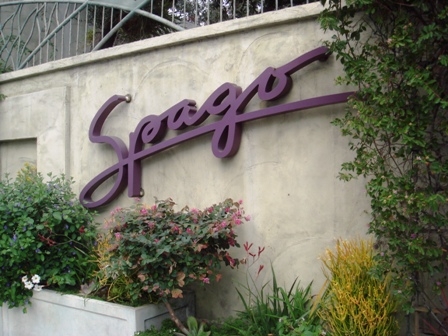
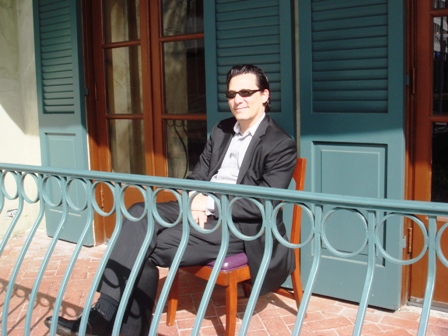
I arrive by Spago, and I see Christian Navarro, taking the sun, with a look à la Mickey Rourke.
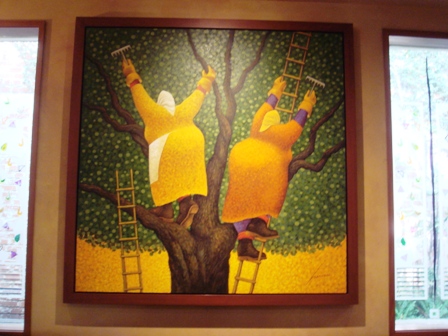
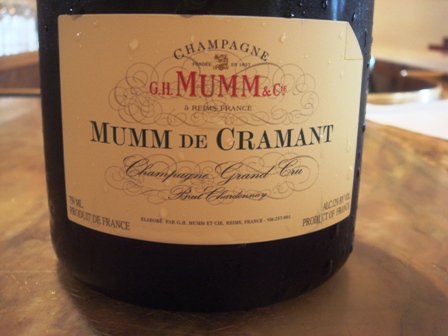
In the main room which we will not use, this painting is reproduced on the menus that each of us will receive. The welcome champagne is this Mumm de Cramant of Mumm.
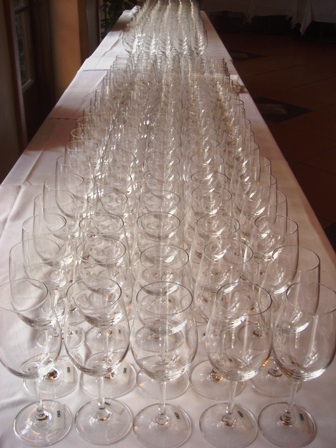
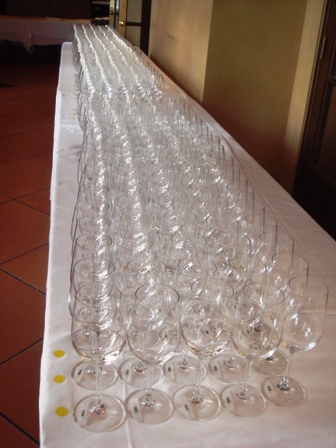
These two groups of glasses have already the year printed on the foot, ready to receive the golden liquids.
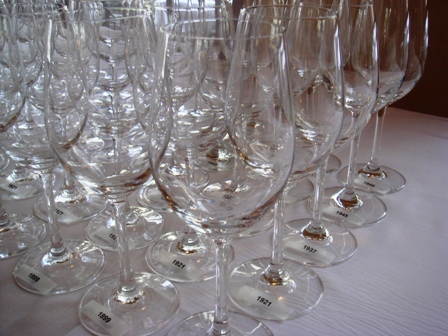
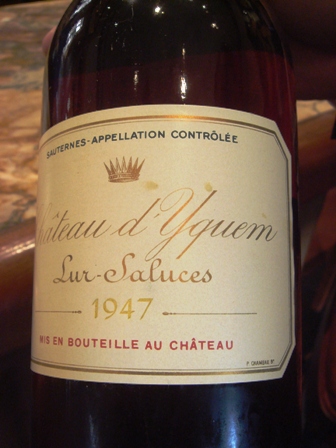
On the feet on the left : 1899, 1921, 1937, 1945, 1949. Even empty, it is impressive.
The magnum of Yquem 1947 is impressive too.

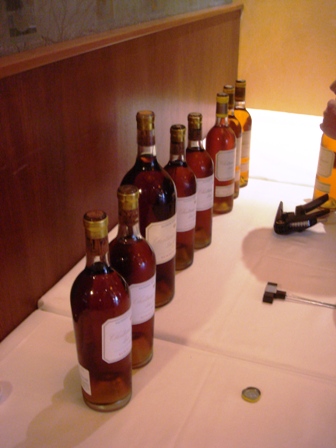
Nice bottles. In front on the right, the two 1948.
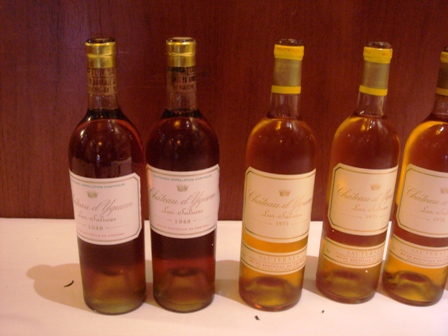
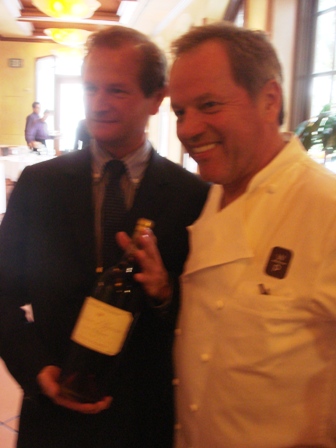
The picture on the right is not precise enough, but I would like that Pierre Lurton having in hand the magnum of 1947 would be together with Wolfgang Puck, the talented chef.
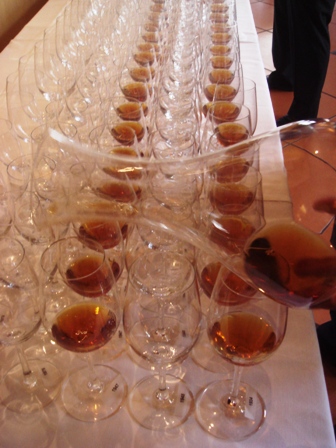
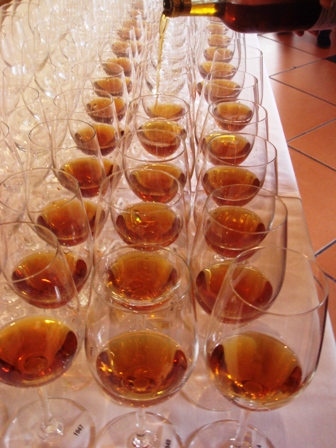
The 1947, 1948 and 1934 are poured.
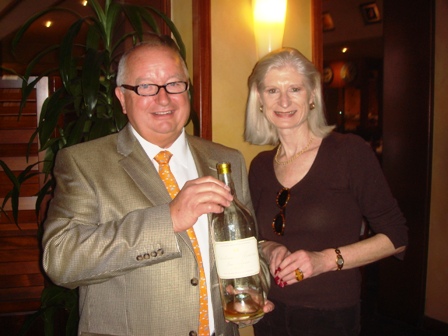
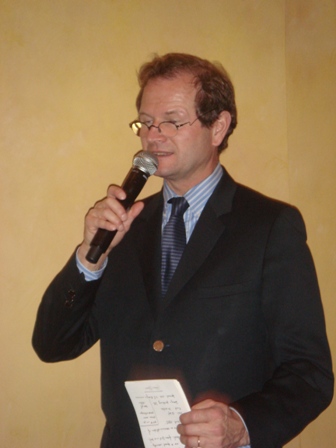
I wear the empty magnum of 1947 in the company of Serena Suttcliffe. Things begin to be serious when Pierre Lurton explains the wines of Yquem.
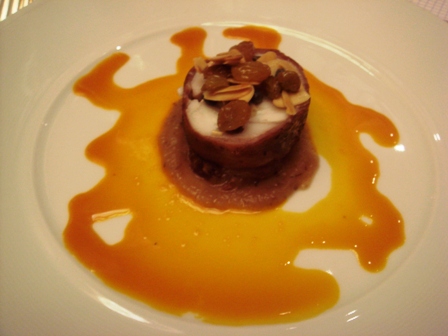
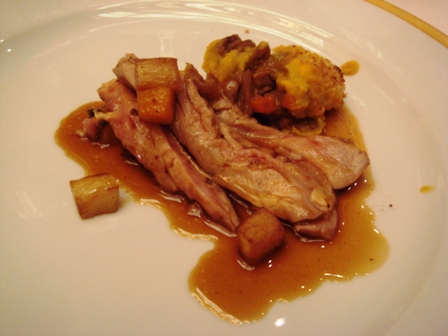
The sauce, on the left, was incredibly good with the wines.
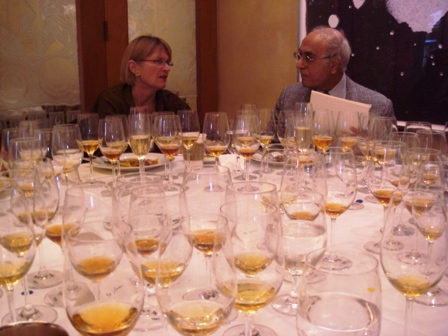
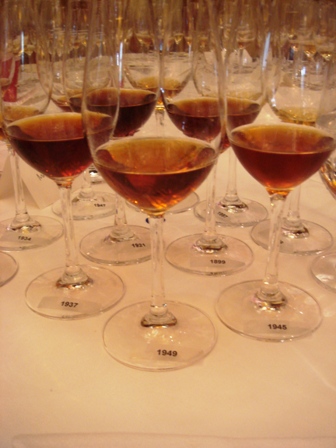
Jancis Robinson talks with Bipin Desai. The picture is taken from my seat. In front of me, on the first row, 1937, 1949 and 1945. Behind, two monsters, 1921 and 1899. To have these glasses in front of me is incredible.
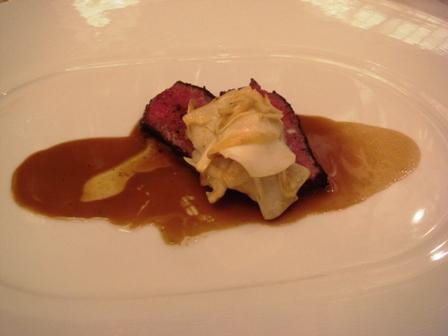
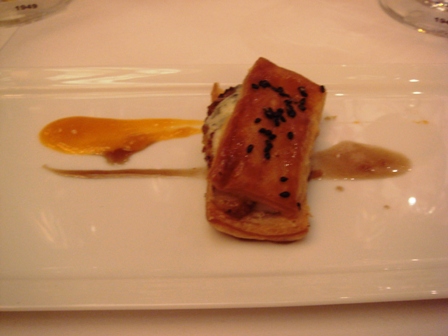
The Kobe beef was a pure marvel with the old Yquem. The Stilton was OK but the Roquefort was too intense.
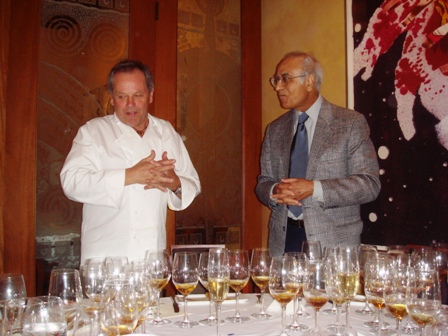

Wolfgang Puck the brilliant chef and Bipin Desai exchange nice words.
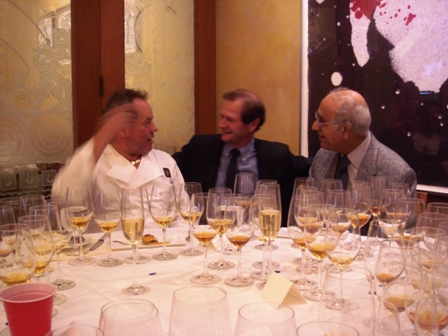
Pierre Lurton joins the group. Wolfgang is always so moving that I was unable to take a picture with him being quiet.
A fantastic lunch (see report).
After a small break following the great lunch of the greatest Cheval Blanc, we met again for the first meal devoted to Yquem, a dinner by Chinois on Main, with the cook of Luis Diaz and Rene Mata, and with the supervision of wines by Christian Navarro. The tasting is conducted by Bipin Desai and the guest of Honour is Pierre Lurton, who will give very precise data on every year with dates of crop, yield, proportions per variety of vine, alcohol, acidity and sugar levels. As I arrived early from my hotel, I could see all the golden bottles standing under the benevolent protection of a Buddha, whose face seemed to indicate that such devotion was accepted by Him.
The menu consists in : passed hors d’oeuvre / Pithivier of stir-fried squab with roasted sweet potato puree / Santa Barbara prawns on sweet and sour beets with sesame seed and plum wine emulsion / roasted Kurobota pork loin with slow braised shoulder, dry apricots and toasted almond / upside down passion fruit cheesecake with pineapple sabayon.
Except the pork loin, I have not been impressed by the attempt of matching with Yquem, which can be achieved better. But the place is so charming and the staff is so active that we spent a very nice time.
I just give an anecdote which made me smile. When I make dinners with great chefs devoted to old wines, I ask them to simplify their cook, telling them that a simplified cook can be delicate and can show the talent of the chef. When the pork loin arrived on the table, there were just slices of meat, with no sauce, no extra accompaniments. And I thought : “wow, they understood what will fit to Yquem”. And then, a waiter comes with a huge pot and fills the plates with another meat (the shoulder), with vegetables and sauce. I had rapidly eaten the simple meat with an Yquem, just to check that it worked well. The more complex dish was heavier to be a real friend to Yquem.
The first flight : Yquem 2003, 2000, 1998, 1995, 1982, 1970
The examination of the smells is not of a great help for such young wines. I just noticed that the greatest nose was the one of the 1970, which is normal as it is the oldest. The 2003 has taken body since the last time I tasted it. I see fig, fat fruit, oriental pastry, as the wine is opulent, fat. A really great wine.
The 2000 is more elegant, more discrete, but the sugar appears more. It is a less interesting Yquem. The 1998 is neatly lighter. A more limited Yquem which never convinced me. It has not the personality that the others have. The 1995 that Alexandre de Lur Saluces complimented a lot at its first appearance is elegant, but I find it too monolithic, too simple. The 1970 is now on my lips : this is a wine ! The sugar is very scarce, the elegance, sweetness and charm are there. It is probably not the most imaginative, but I like its airiness on mouth and its apricot taste. The 1982 has a very nice attack with citrus fruit. It has balance, structure, serenity. It is typically a wine for gastronomy.
My ranking : 1982 – 2003 – 1970 – 2000 – 1995 – 1998.
The ranking considering the potential would put the 2003 above the 1982.
Second flight : Yquem 1986, 1961, 1953
The colours of the two older are fantastic. It is what Yquem should look like. The 1986 is slightly bitter, but with time, it has gained in elegance. This wine has been a sleeping beauty for a long time. It is very probable that it will have a positive development. With the 1961 we enter in a new generation of Yquem. This wine has balance, but more than that, an easiness à la George Clooney. It is in a mango phase. The 1953 is completely feminine. Contrarily to wines which require a dish, this 1953 has such a lovely sweetness that it should be drunk alone, to enjoy the subtlety.
Pierre Lurton finds that the 1961 has a rather bitter final, but in fact this wine abandons progressively its sugar and becomes dryer, as it happens more frequently for the decade 30ies.
Tasting again the wines I find that the 1986 would go very well with a lobster, and even if the final is not the most spectacular, I find it pleasant. The 1961 gets notes of tea, dries a little but is a nice wine. The 1953 is excellent.
My ranking : 1953 – 1961 – 1986.
Third flight : Yquem 1983, 1967, 1959, 1955
In the 1983, the sugar is very noticeable, but compensated by a nice acidity of citrus fruit. It is a classically good Yquem.
The 1967 has an attack of tea, of bitter wood. But the volume of this wine is enormous. It is very interesting as it is absolutely not conventional. I love the unconventional aspect of this wine. The 1959 is very light, airy and subtle. What a contrast with the 1967 ! It is extremely elegant. The 1955 is the synthesis of the two previous wines. It has everything. There are candied fruits. The final is imposing.
I make a second and a third round to try to decide which the first is as it is complicated. The 1967 is very big, but has aspects of tea. So, I prefer the 1955. The 1959 is greater and greater. It is extremely difficult to choose. I begin to write 1955 – 1967 – 1959 – 1983.
But in fact my ranking is : 1955 – 1959 – 1967 – 1983. The fact to put the 1967 only in third place shows how good the two others are. Bipin says that the 1967 is the most “exotic” of all the Yquem and says : “it is the more Pomerol of Sauternes”.
The 1955 has elegance, the 1959 has a peppery final, the 1967 has an incredible power, and it’s a bomb. The 1955 is the lighter one, but for me it is exactly in the historical line of Yquem. I come back to the previous flights with the 1982 which is very good and the 1970 which does not keep the distance.
All of us we talk of our choices, which are very different, and the question which arises to me is “what do you expect from an Yquem?”. It is clear that some people want power, which is not my search. It explains why the preferences were very different. It is a good thing, as every Yquem will have its fan club.
It was a wonderful evening, with nice wines and a rather disappointing food, as the chefs did not enter in the world of Yquem.
Our group meets again the next day for lunch. The fourth event of this incredible serie of tastings is a lunch by Spago Berverly Hills, with a menu composed by Wolfgang Puck, a talented chef whose origin is in Austria, and with the efficient management of the wines and the glasses by Christian Navarro. Pierre Lurton is once again the guest of honour of the lunch organised by Bipin Desai.
The menu consists in : hors d’oeuvres / wood oven-roasted, prosciutto-wrapped Maine monkfish with onion-date puree and Thai spices / roasted breast of Scottish pheasant with shepherd’s pie of braised leg and butternut squash / grilled Snake River Ranch Kobe New York steak with Matsutake mushrooms / Stilton and Roquefort / apple and fennel sorbet with pixie tangerines, lime marinated persimmon with anise wafers.
This has been the most elegant cook, perfectly adapted to old Yquem, and I am so happy that the chef had the courage to propose a Kobe beef on old Yquem. It worked wonderfully. I am in favour of such risks, and it pays.
The first flight : Yquem 1976, 1975, 1948, 1947, 1934
The deepest colours are the ones of the 1947 and the 1948. The 1934 is lighter, and in my glass a little troubled, which does not appear for my neighbours. The nose of the 1975 is corked, and I learn that for the other group, it is the 1976 which is corked. We exchanged a part of the good pours for the ones having the corked pours.
The nose of the 1948 is marvellous. It has an incredible strength and could be smelled as an alcohol. The nose of the 1947 has an infinite subtlety. It is as sexy as a perfume. The nose of the 1934 is balanced and sweet. The nose of the 1976 is very strong in alcohol.
The 1976 in mouth is very fat, suggesting candied fruits. A very excellent Yquem. The 1975 does not suffer too much from being corked. But it is not what it should be. I can imagine that it could be great. I received parts of two glasses of the good 1975. I was not convinced at all, as I do not like so much such manipulations.
The 1948 is an angel who comes smoothly from the sky. For me, it is the expression of happiness. Nothing is exaggerated, all is delicious. There is even a little of butter in the taste. This Yquem is “the” Yquem that I would wish to drink for ever. A pure dream. We will drink later some Yquem that I will rank above, due to their outstanding performance. But this one is for me a pure joy, as the old jacket that you cherish. You have clothes with very expensive cut or material. But there is one jacket- generally rather old – that you wear with a total pleasure. This is what I find in the 1948.
The 1947 has an enormous power. It is a Sumo. It is perfect, but for my taste, I prefer the more subtle 1948. The 1947 coming from a magnum is glorious. The 1934 is very surprising. For my opinion it has changed its original taste, evolving towards a combination of alcohol and matured oranges. If this wine were drunk alone, we would find it absolutely superb. But put together with the 1947 and the 1948 it is a too heavy challenge. I try again and I find in the 1947 a total perfection. The 1948 is of a total charm, but I must say that the 1947 is greater. The sauce is fantastic with the wines, Wolfgang Puck, who has tasted all the wines (not bad !), has adapted the sauces to the wines. The 1947 and the 1948 are equal in my ranking, and the 1934 is the best 1934 that I have ever tasted, as all the elements are now integrated. The 1976 is great, the 1975 lacks of charm. Finally, the 1948 is what I look for in Yquem, so I will put him as first.
My ranking : 1948 – 1947 – 1976 – 1934 – 1975.
Bipin asks me to make comments on the wines, and I say that when I have in front of me the total perfection of Yquem, I am like a kid in a candy store, I enjoy !
Second flight : Yquem 2001, 1997, 1990, 1989, 1988
The 2001 appears to be much sugared, it evokes candied fruits. I feel the enormous potential of this perfect wine, but it is very difficult for it to be served after the 47 and the 48. The 1997 is very elegant, easy going, peppery. It is the type of Yquem that I like. I find similarities with the 1948.
The 1990 offers coffee, blond fruits. It is nice, but it lacks length. Very fruity Yquem. The 1989 is very citrus fruits. Lighter than the 1990 it is very elegant. Citrus fruits, with a very nice and elegant finish. The 1988 is the more balanced. It has not many singularities. It looks as if it would be “established”. The 2001 is in a phase when the sugar dominates. It is not at its advantage and we should wait before drinking it again. The 1997 is the recent example which is the most in the historical line of Yquem. The 1988 is too politically correct. It plays a little under its talent. I was in the camp of those who prefer the 1988 in the trilogy, but here, it is the 1989 which is the nicest. The 1989 is the most elegant, and the 1990 shows too much its sugar.
For an immediate pleasure and not on the potential, my ranking is : 1989 – 1997 – 1988 – 1990 – 2001. The greatest potential is for 2001 and 1988. But now, the freshness of the 1997 and the balance of the 1989 put them at the top.
After several new tries, the 1988 becomes greater than the 1997, so my final ranking is 1989 – 1988 – 1997 – 1990 – 2001.
Bipin says that the 2001 is “larger than life”. Every aspect of this wine is above any norm.
Third flight : Yquem 1949, 1945, 1937, 1921, 1899.
It is hard to imagine having these five glasses in front of me. I see around me that it seems natural. But it is not!
Ranking the colours from the more deep to the lighter, it gives : 1921 / 1899 / 1937 / 1945 / 1949. The nose of the 1945 is very elegant. The nose of the 1937 has an infinitesimal problem. The 1949 evokes brown fruits. The 1921 has the absolute purity of a perfect smell. The 1899 has an elegant racy nose. The total nobleness.
I begin to drink. The 1949 is totally elegant, with a rather short finish. It must be said that all these wines are above 100 points. So to criticise is like to say : “ I do not like so much the curve of the nose of Mona Lisa”. All what I have to say about the 1945 is that it is totally perfect. It is elegant and has a fabulous balance. It is exceptional with an enormous finish.
The 1937 is more fluid, acidic, very much in the style of the decade 30ies. It is very different from the style of the 40ies. There is grapefruit, green citrus. It is a wine for gastronomy, a great Yquem. The 1921 is completely atypical. There is tea and coffee, but also lemon. The length is unique. It is great, opulent, and comfortable. If I had to make a critic, I would say that it lacks a little of eccentricity.
The 1899 is a truly great Yquem. Tea, candied fruit, combined with green lemon, and the sensation is above the one of the 1921. In the 1899 there is alcohol, in the 1921 there is caramel, and my taste is not so much in favour of Sauternes which have developed their caramel side.
My ranking : 1899 – 1921 – 1945 – 1937 – 1949. But, how many wines in the world could be ranked above the fifth of this flight?
I had changed my vote several times as it was difficult to say between the 1945 and the 1937. The 1945 is a little more singing and sunny.
I come back to the 1947 of a previous flight which has developed a taste of dry grape. And it is very rare.
My final ranking for this evening is : 1899 – 1921 – 1945 – 1948 – 1947 – 1937 – 1989 – 1988 – 1976.
If I say now that the 1899 that I shared in Yquem with Pierre Lurton was above this 1899, one can imagine what I had lived at that moment.
This tasting shows that the older Yquem is, the best it becomes (if one chooses the great years), and it shows that the decade of the 40ies is super performing. I said that what is unique in Yquem is that for almost every wine, we could say that we had the best possible bottle.
To open an Yquem is certainly what gives the greatest chance to have an immense wine. We were lucky enough to have Pierre Lurton bringing so many fabulous wines. Bipin Desai organised the flights with a rare intelligence. Christian Navarro made a fantastic job to give us wines in a good shape and a good condition of tasting. Wolfgang Puck made a magical cook which gave ideas to Pierre Lurton to dare more with the food.
Everything was perfect. The four meals that we had will belong to the group of the best events that I have lived.
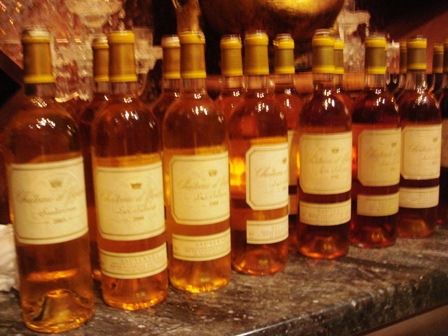
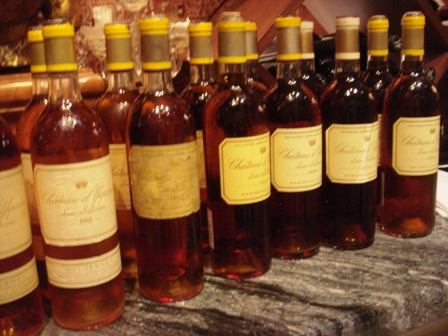
The bottles for the tasting.
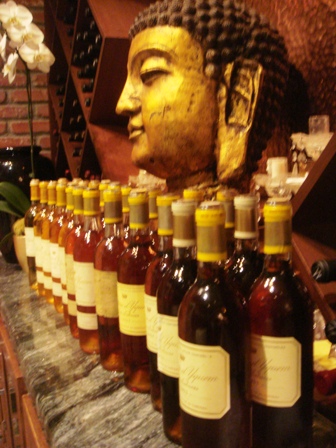
Apparently, Buddha accepts this present.
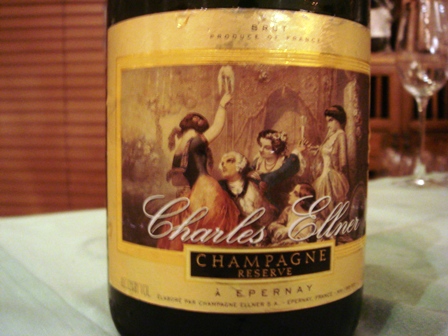

The welcoming champagne is Charles Ellner in Epernay. One great Yquem (see report).
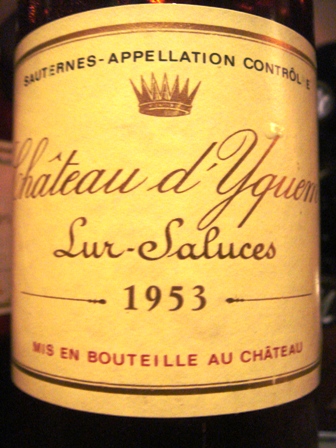
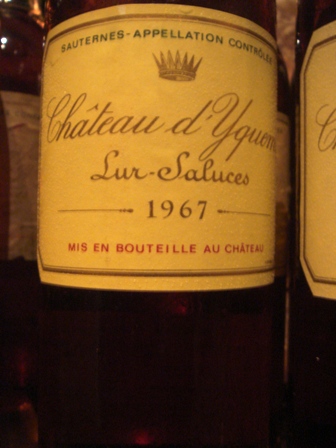
Two legends (especially on the right).
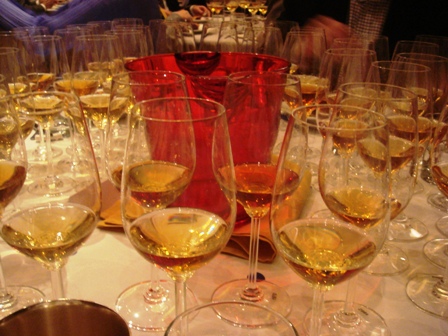
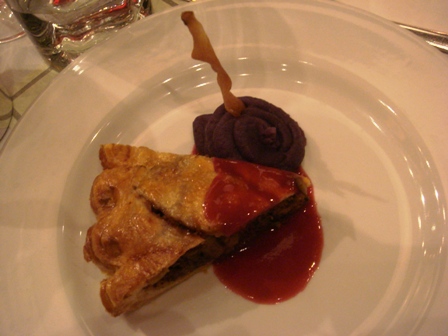
This pie was not adapted to "young" Yquem with light colours.
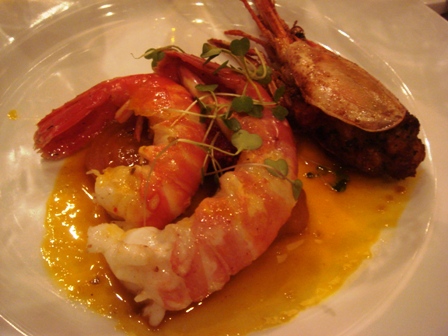
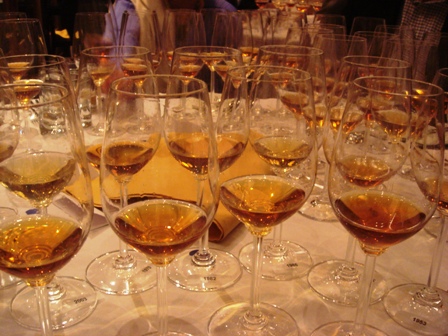
The prawns were largely better with more mature Yquem.

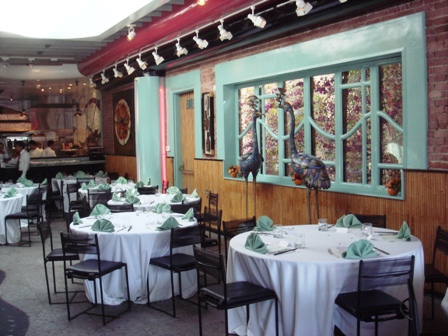
The main entrance on Maine Street. The room prepared for our tasting. Note the wall full of orchids.
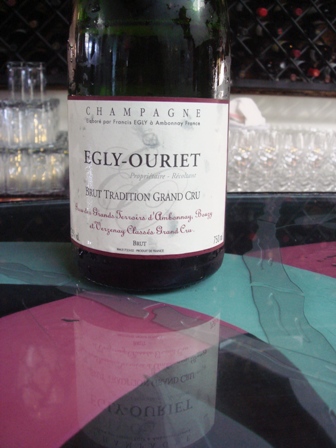
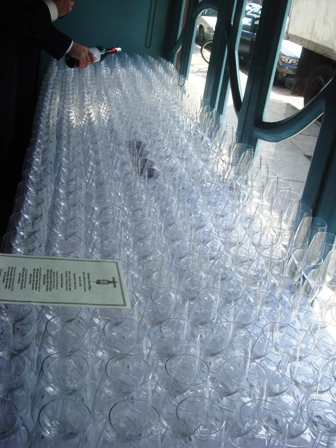
The welcoming champagne is an Egly-Ouriet. The glasses are filled.
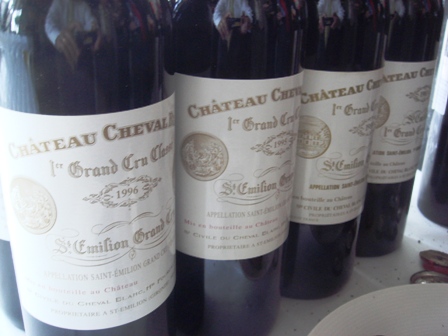

Some bottles ready to be poured in the glasses.

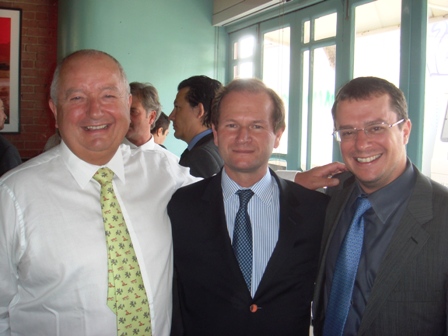
Myself, Pierre Lurton President of Yquem and Cheval Blanc, John Kapon, managing director of Acher Merral, an auction house, and a great palate, used to the best.
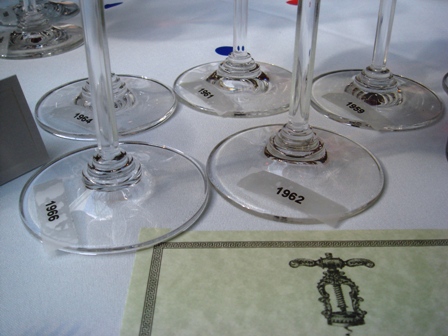
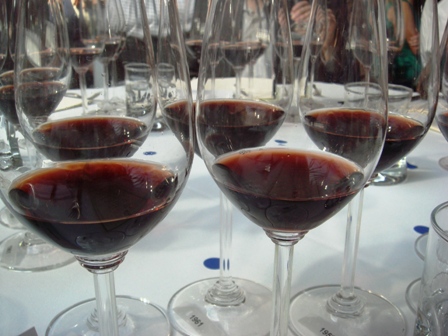
Some very nice wines.
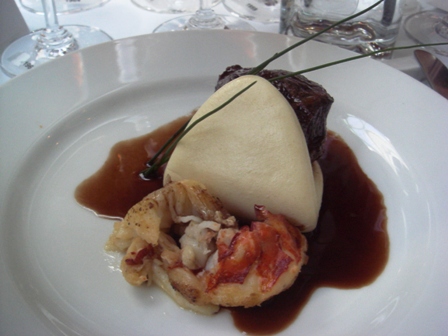
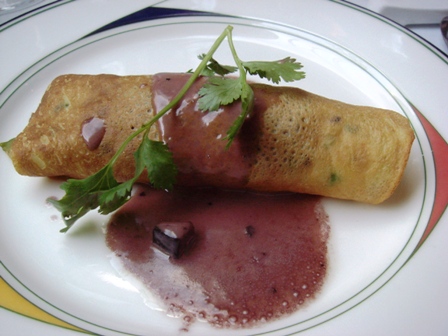
A nice cook, but sometimes too spicy.
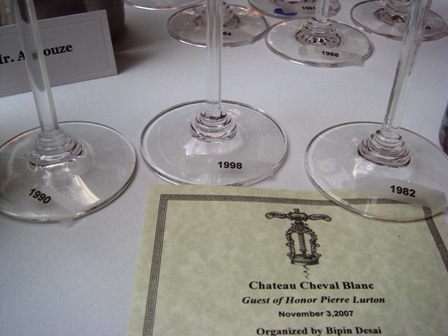
It shows that I was there !!!
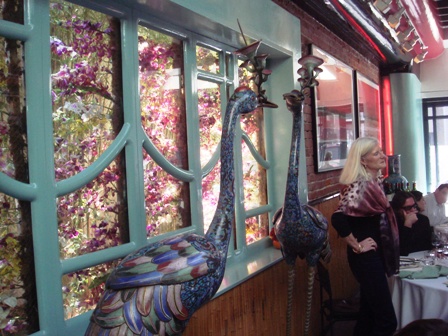
To see Serena Suttcliffe addressing the audience near these two birds is a coincidence. But her lovely scarf fitting wonderfully with the orchids is remarkable.
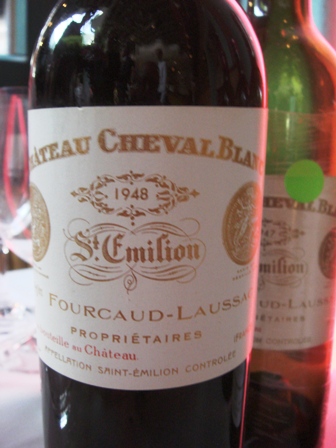
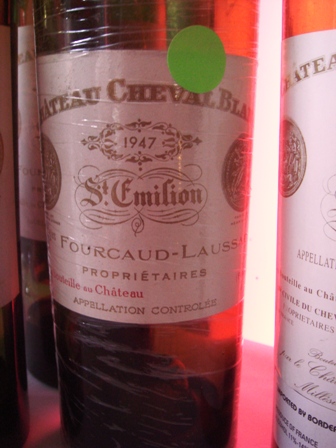
A wonderful 1948 and one of the 1947.

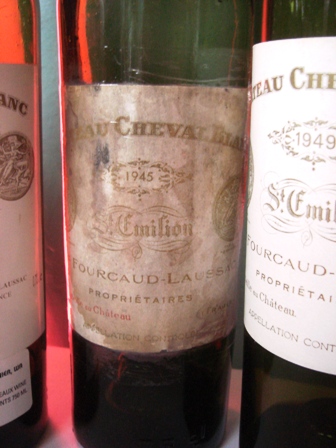
The two 1945. I prefer largely the bottle on the right.
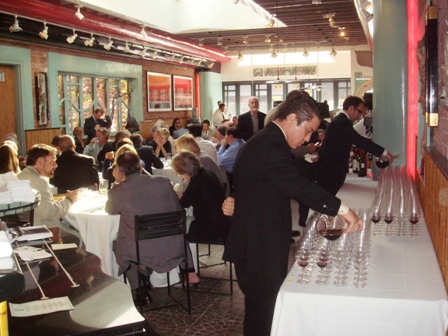
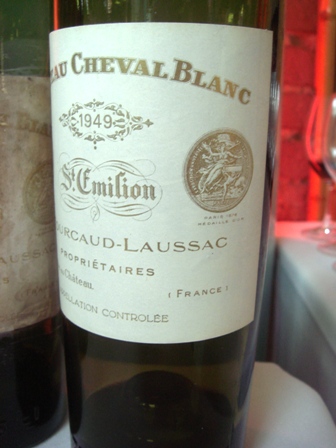
The service of the wines. Cheval Blanc 1949.
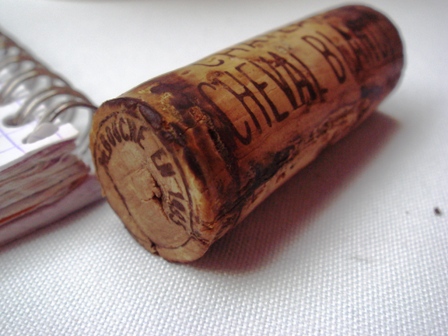

The cork of the 1921 raised questions. As the recorking date was printed on both ends of the cork, we have judged that the bottle was a true one.
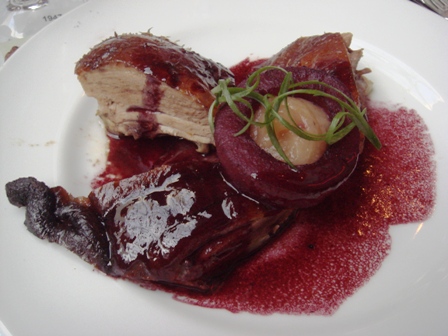
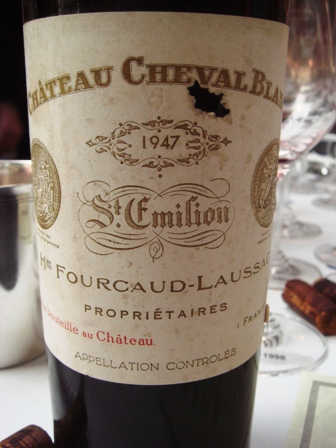
One typical dish of Chinois, and one 1947, probably the one which was not used.
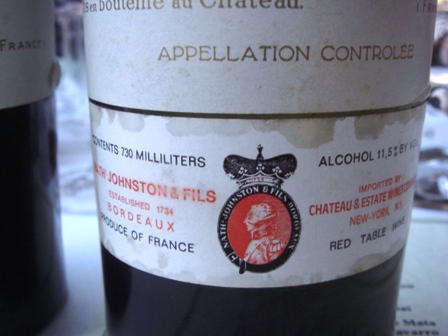
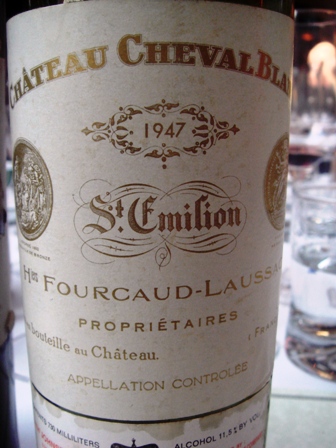
Two views of the 1947 which was the best. Read the reports, on a message of the same day.
Tasting of Cheval Blanc in Los Angeles – report of John Kapon, head of Acker Merrall auction house.
John makes remarkable notes on wine tastings and is one of the references in tasting of old wines. Notes can be found on his web site.
The stars were once again aligned for a spectacular weekend in Los Angeles, orchestrated by none other than Dr. Bipin Desai. While the BCS standings may have been on many people’s minds heading into early November, it was the BCW (Bipin Cheval Weekend) that was on the collective collectors’ minds of those fortunate enough to get a seat at this sold out event. Bipin has become renowned for his wondrous wine weekends that he holds periodically in Los Angeles, as well as Bordeaux, Paris and other parts of the globe occasionally. This weekend brought Bordeaux to Los Angeles, along with Pierre Lurton, managing director of Cheval Blanc and d’Yquem. He was on hand to guide us through 35 vintages of Cheval Blanc, St. Emilion’s most collectible wine, and this weekend would prove that claim to be deservedly so.
Most of the wines came directly from the Chateau, which is a rarity when it comes to older wines. In fact, demand has been so great in Bordeaux at the top Chateaux that one could say it is becoming a rarity for younger wines as well! But to find wines seventy years or so old from the Chateau is very rare and a testament to the library at Cheval Blanc. Even though Bipin had two bottles of every wine for this event, he told me that the demand for this event was one of the most extraordinary that he has ever seen, and he has done hundreds of these wine weekends. He actually had to turn people away, as much as that pained him.
As usual, it was Friday night, and I had just stepped off a plane in time for dinner. I smelled all the wines first for each flight. I was feeling a bit under the weather, though the wines of Cheval Blanc quickly brought good feelings back.
We started with the 1988, whose nose was fabulous, again, since the last time I had had this wine was with Pierre himself at Cheval Blanc. This bottle also had great aromas of sweet red fruits, green and black olives, cherry, nut and a touch of cola. The palate was red and rusty with nice tannins and alcohol. The 1988 is in a great spot right now, and Michael Twelfthtree, famous Australian winemaker, was also loving it, and James Suckling admired, its ‘really fresh quality and licorice’ (93).
The 1985 was a bit milky in the nose, with lots of bell pepper up front. There was earth and beef behind it and very subtle red fruits. It opened up more to reveal brooding and deep t n’a. The palate was really big, chunky and muscular, with black olive and black fruit flavors. It was a big wine by Cheval standards, and although James found it a bit off, I found that in time, it found itself in the glass. It was massive compared to the 1988 (95).
The 1979 was similar to the ’85 with its upfront bell pepper and touches of milk, earth and beef. There was also a pinch of szechuan; ’79 seemed like the ‘85’s little brother, possessing less overall of everything. It got greener in the glass and revealed wintergreen flavors. It lacked length, but was still very good. Pierre admired the ’79, citing that ‘acidity is the backbone of wine’ (90).
Pierre also noted that the 1978 was picked rather late, on October 8th. There were lots of green olives in the nose, and again that touch of bell pepper, but the green olive was the dominant trait herein. It was musky and more aromatic in the gamy direction, and also more forward with its earth components, a bit toasty with lots of campfire qualities. Fleshy, rich and very tasty in the mouth, it possessed light rose and a kiss of green olive and mint (92).
The 1975 evoked Gil, aka Mr. Wine Vegas, to call this, ‘the bell pepper flight.’ The ‘75 had more wintry and waxy fruits to go with its green olive, and it also had some animal, complete with fur. The palate was rusty but also a bit musty with hot tannins and flavors that were a bit dried out. Pierre remarked, ‘In general, there were unbalanced wines in 1975, and a big wall of tannins in most’ (88?).
The 1971, my birth year, was very pungent and olive-y. It was the most open of the flight, wintry and minty in its personality, but also possessing red fruits, almost red citrus fruits. It was round and soft with a nice hint of sweetness to its fruit, yet still rusty.
Subdued yet forward and expressive, Gil and I preferred the 1971 to the 1970 that followed. Gil observed, ‘Cali weed and rose petals in the nose.’ Pierre also preferred the 1971 to the 1970 (92+).
Bipin preferred the 1970, whose plummy, nutty, figgy and gamy qualities set it apart from the rest of the flight. There was just a touch of menthol and cedar in its singular nose. The palate had nice richness and more plum flavors, meatier in style, and its acidity took over in the glass. Francois Audouze, our Parisian representative, hailed the 1970 as best of flight, followed by the 1988, 1971, 1985 and 1978, in that order (90).
The warm-up was over, and it was time to get serious for the 1955. The 1955 had a complex nose of wheat and exotic, jammy, smoky, sexy red fruits. Sweet and kinky, it had the cherry, raspberry and strawberry trifecta. It was almost as if a shot of Yquem was in the glass; it was that sweet. The palate was gamy and figgy, a touch oxidized, but in that natural date and cola way. There was a bit of ‘old painting varnish’ according to Gil. It did have that round autumnal edge to its fruit flavors (93).
The 1953 saw a return to the smoky, campfire aromas previously seen in the ’78. Fresh and also sexy, it occurred to me that this bottle was perhaps reconditioned, and indeed it was, in 1985. Big time cinnamon aromas emerged. There was great elegance and balance to the palate, and flavors of raisins, red fruits and wintergreen abounded. It was gorgeous, but just ‘not the best bottle that I had’ according to someone (94).
I should note that many of the older wines came directly from Cheval and were reconditioned. Although I am generally not a fan of reconditioning, I must say, for the most part, that Cheval did a particularly good job with their reconditioning, and that outside of the general freshness of some of the older wines, it was tough to say that many were definitely reconditioned. Due to the format and timing, I was not able to find out exactly which wines were reconditioned for this session, although I managed to find out more for the second session that followed on Saturday.
The 1952 didn’t taste right to James. There was cinnamon again, ‘solera’ according to Gil. It also had some hoisin. The mouth had that touch of metal, definitely reconditioned and probably the worst job of the evening. It was simply not what it should be, but others found it spectacular, which meant that the second bottle (which I did not try) was better than the first. This wine should be in 95-97 point territory; it can be killer (90?).
The 1937 had old cobwebs in the nose, with lots of dust and rust that gave me a haunted house impression. It was fully mature; beautiful, long and caressing with great old flavors (93).
The 1934 had a ‘whiff off doggie poo’ right off the bat, almost masquerading for Burgundy, according to Gil. James also observed that he forgot how Burgundian Cheval can be. There was great aromatic complexity in the ’34; rust, earth, wintergreen, old book and carob were all present. The palate was round and rich with great t n’a, but the acidity is what really made this wine stand out from every other so far. ‘What acidity!’ was how I put it, to be exact. There were also complex caramel and rust flavors on its lengthy finish. Christian Navarro loved the ’34 the best, and Michael La Tondre also said that the ’34 was his favorite, noting its, ‘Cohiba cigar, candied raspberry and tremendous finish’ (96).
Now began the flight of young bucks, beginning with the 2004. The 2004 was obviously a baby by comparison to the wines that we had just had, and it was full of baby fat fruit accordingly. It was still sappy and sweet with lots of dark, sweet fruits, incredibly concentrated and full of crushed black cherry and black raspberry oil. The palate was rich, balanced and long, possessing big time chocolate flavors and earthy spice. The fruit was rich, full of coffee flavors, with excellent minerals on its concentrated finish (93+).
The harvest in 2003 was the earliest picking since 1893. There was even more coffee and chocolate in the nose, along with a touch of beef stew and hot earth and smoky aromas. The palate was ripe and forward, gamy and sweet, a bit of a floozy. It had ‘light brick with lots of dark chocolate’ flavors per Gil, and lots of liquid vitamins on its finish (92).
The 2001 was very aromatic with its candied red and black fruits and had a splash of cough syrup. Tangy and sweet, it also had this almost blueberry profile, most likely due to a large percentage of merlot. There were lots of coffee and vitamin flavors. It still had classic fruit, nice definition and beautiful balance. The tannin was very vimful, and those vitamin flavors really made me lick my mouth. It was another excellent right bank wine from the 2001 vintage (94).
We entered the evening with a bang, that being the 2000. Big, chunky and clearly on another level, the 2000 had huge breed and divine aromas of chocolate, coffee, espresso, graphite, black cherry, blueberry, motor oil, vitamins, pine forest and cedar. Now that’s a complex nose! The palate was exquisite; long, fine, balanced and elegant. It reminded me what the 2000 Bordeaux tasting did; 2000 is the new 1982 (96+).
Saturday brought us back for lunch at Chinois, where nineteen more wines awaited us eager participants. Friday night had left us wanting more, and Saturday definitely delivered. We started with the 1999, which had a shy and brooding nose. It was a much more masculine style of Cheval. There was lots of earth and minerals, and slowly penetrating t n’a in its very cedary nose. The wine was round and rich in the mouth, again cedary yet also foresty, long and big in its profile. Its taut, rusty fruit was a bit square, and it seemed that this wine has closed up a bit since the last time I’ve had it a few years ago (92).
The 1996 was also cedary, yet olive-y, and its wood qualities were a kiss too much; in fact, it had the most noticeable oak of the weekend, and that’s not a good thing. The palate was better, more olive-y yet still cedary and square, but it had a tasty edge that the ’99 lacked. Medium weight, tender and tangy, the ’96 had red fruit flavors, and I preferred it to the ’99 on this day, but would much rather have the ’99 in my cellar. The oak blew off a bit, and while everyone ultimately liked the 1983 best in this first flight, most also preferred the 1996 next. It was the most open and friendly in the flight, but it also had the least weight. Someone observed, ‘smoked chili, light raspberry and invigorating minerality’ (91).
The 1995 had much more wildflower and lavender in the nose, yet was again cedary with bell pepper and chocolate aromas. In the mouth, the wine was round and rich, with lots of t n’a, flirting with hot. Its fruit flavors were rusty, and there was citrus on its finish. It opened up and had a real rusty ‘pop’ to it’s a finish, so much so that Bipin called it a ‘revelation’ (92+).
The 1989 was the greenest of the bunch, as always, with lots of bell pepper, olive and this puttanesca tomato sauce edge, so much so I wanted to throw some pasta in it. The ’89 was actually in a tasty spot, but it seems very forward and on a fast track to maturity. Lush, round, fleshy and tasty, it had sweet green pepper flavors that won’t get any better. Pierre observed its overall merlot and leathery nose. Although I think it won’t get any better, this bottle of ’89 was in a good spot, and even though it was green, Jef professed that he liked it with ‘I like green.’ Shroomy qualities developed as well (93).
The 1983 Cheval Blanc was punishingly wound, with searing t n’a, minerals and sawdust. I had to swirl what seemed like 1,000 times to get past the minerals, but behind the minerals were sappy, menthol, olive, game, wintergreen and asian spice aromas along with meaty fruit. The palate was round and rich with tremendous acidity that seemingly lasted forever. The ’83 shattered the rest of the flight, and its great core of rich, red fruits, brick, fireplace, asian spice, hay and minerals even left Bipin, ‘very impressed.’ That same someone from before admired, ‘uncountered delicacy, dust, earth and bouillon’ (95+).
The 1983 reminded Jef of how he likes the concept of great ‘shadow years,’ ie the vintages after the great years like 1983 after 1982, 2001 after 2000, etc., and has been very successful with some purchases along those lines.
The next flight began with a 1966, which had wonderful aromatics, although Serena Sutcliffe, whom I had the pleasure of sitting with, was very sensitive to some chlorine in the glass. Once we worked past that, there were tender and sweet aromas of winter, cherries, minerals, earth, candle wax and a touch of sexy sweat. While the aromatics were nice, the palate was very, very dry and lean, with no sweetness whatsoever and a citrus-y, dry and uninspiringly earthy personality (88).
The 1964 formed an instant glee club, with Serena, Ed and Jef loving every minute of it. It was very fragrant, with lots of red fruits but also this cassis and fig quality. It was very stony with lots of t n’a, but this ’64 was all about its great fruit. Round, balanced, long and tender, its flavors of old sweet cherry, tender leather, mineral and book were flat out beautiful (95).
The 1962 had a super sweet, long nose that was very plummy, chocolaty, figgy and a touch yeasty. There were nice dusty flavors, and the ‘62 was along the lines of the ’66 stylistically in the mouth, but it had some shreds of fruit left, a pat of nice cassis left in its round and smooth palate. It got a little limey in the glass, but not negatively (91).
The 1961 had a killer nose that was very racy with lots of vigor and t n’a. It was also very sweet in a musky, nutty, caramel-y way. There was lots of oil in this rich and nutty wine, and as soon as I tasted it, I flashed to 1971 and ‘76 Grange. This menthol/eucalyptus craziness was total Grange. It was rich, hearty and full of strawberry flavors. Bipin concurred that ‘this was always one of the sweeter ‘61’s,’ and likened it to a ‘bon-bon’ (94).
The 1959 had a reticent nose with some sweet caramel creeping out. Francois fell in love with the ‘59 immediately, calling it, ‘completely perfect’ and having a future that will last ‘forever.’ The nose got deeper, chunkier and beefier, while hints of bread and dust and acidity oozed out slowly yet firmly. The palate was rich and creamy, absolutely delicious; it was so creamy and so sexy that it was easy to see how it tickled Francois’ fancy (96).
Bipin spoke about the fact that ‘every bottle was what it should be…candied sweetness and all…all the alcohol levels are 12.5% or less, and people say you need alcohol to age.’ I believe I heard a ‘harumph’ out of him next. He also went on to say that in the sixties, many wineries chaptalized to get the alcohol levels just to 12%, but today, due to the climate change, wines are naturally 13-14% alcohol. This was one of the most fascinating comments made all weekend, and it really made me think about the state of winemaking then versus now. Today, winemakers seem to be pushing the envelope as far as the alcohol levels in their wines, partly perhaps due to climate, but mainly due to intention. After having tasted so many glorious wines over the years from the 1870s up through the 1980s (I think it is safe to say that higher alochol levels are a product of the ’90s until now), how could one argue that wines could age any better with higher alcohol levels? I am no chemist, and I have not done any lengthy comparative studies, but I do know that most winemakers whose wines I prefer always talk about acidity and not alcohol. Even Pierre acknowledged acidity as the backbone of wine earlier, and if you talk to the Burgundians, it is all about the acidity as far as aging potential. Perhaps high alcohol levels are not at all what they are cracked up to be.
The third flight was again full of young bucks, but this trio was high powered enough to put the Three Tenors to shame – make that Three Mo’ Tenors for Manny and Wilette (go see it New York!). The flight began with a 1998. The 1998 had a great nose, wound up a coiled, yet deadly with its venom, packed with sweet, sappy and dark purple fruits. There were lots of minerals, along with black cherry and cola aromas. The palate had great minerality. It was long, elegant and fine, yet substantial. I believe it was Serena who called it, ‘absolutely mind blowing and better than the 2000…crashingly good’ (96+).
The 1990 had a deep, sexy nose full of green olives and wintergreen. It had this open, waify edge to its black fruit and lots of garden aromas as well. The palate was so lush, long and tender with its cascading waterfall of fruit flavors. It was so elegant, possessing garden, forest, and olive flavors. Incredibly complex, Serena also ‘loved it’ (97).
The 1982 had a lean nose by comparison to the first two that was very shy and dominated by wintergreen at first. Touches of roses and cherry lingered behind. The palate was great, however, and it even had a flash of meaty fruit. Elegant yet rich, long yet balanced, tender yet full, this was one of the better bottles that I’ve ever had of this wine, which has been notoriously all over the map, at least in my experiences. This bottle of ’82 had similar qualities to the ‘90 yet more in reserve, almost a nose in winter hibernation. Serena put the ’82 third in this flight of three and found it to be ‘not what you expect.’ I found this flight to be great and a bit of a photo finish (96).
The first wine of the spectacular last flight was the 1949, which was slaty and wound at first, again more of a glass issue than anything else. I couldn’t get much out of the nose accordingly, but the palate was extraordinary. Rich and balanced, there were great slate borders to its decadent cherry core, and great roundness, balance, tannin and definition, and just a twist a tootsie pop to this beautiful, gorgeous wine (95).
The 1948 was even better; the power jumped right out of the nose; that sweet rust, licorice, nut and this ice skating rink/’glace’ complexity and edge. The flavors were so great, so rusty, so spicy and foresty, mineraly, slaty and earthy as well, full of cherry cola. Once again the 1948 stole the show and was ultimately the wine of the weekend, although the bottle of ’47 I would have with Rudy and Gil later that evening would lay claim to the wine of the weekend throne (98).
The 1947 that I had during afternoon’s session was unfortunately a touch oxidized, with this burnt brown sugar quality to the nose, port like in its personality. Thick, long, spicy and rusty, this affected bottle was still drinkable and still excellent. The other bottle of ‘47 served that afternoon had much more rust and life, but I only got a small swallow, and the bottle that I was officially served was (94A).
The 1945 had gorgeous, tender red fruits. Dusty and sandy in its personality, it still had great sweetness in the nose and great flavors to match. Its flavors were more on the citric side of the flavor rainbow, but there was still sweet strawberry as well as flavors of actual straw giving this wine tremendous complexity. The wine possessed superb acidity and was stunningly gorgeous, very fresh and danced in my mouth (96).
The 1921 had cobwebs and tender red fruits in its nose, along with wax and leather. One could see it was very old, but this Nicolas bottle proved about as fresh as a 1921 could be. Very gamy with lots of delicious caramel flavors, the wine was round and old, tender with lots of leather and older flavors, graceful yet forceful (95).
I looked at some of the corks on this day and noted that the ‘62, ‘59, ‘49, and ‘48 were reconditioned in 1985, although it is possible one bottle was and one bottle wasn’t since two bottles were served. The 1966 was reconditioned in 1991, and the ‘64 and ‘61 were original corks, at least the corks that I saw.
Serena gave a great speech at the end of the event, summing up some of her keen observations, so I will share some of those observations with you.
She called 1995 and 1996 ‘an interesting comparison’ and admired the 1995 and its ‘richness of merlot.’ The 1953 had ‘charm,’ while the 1955 was ‘meaty.’ The 1952 was ‘mind-blowing, the best bottle that I have ever had.’ The 1970 was ‘particularly good,’ and it was as if she was looking through a door for Cheval, because that was the last year they bottled in Libourne. The 1959 was ‘utterly dominant, so mouth-filling it wasn’t true.’ The 1988 was ‘always classic,’ and how in general Cheval was exotic with its ‘cinnamon, cloves, Russian leather and sweetness.’ She finally reminisced about how she never thought that people would still be looking for the 1947 over thirty years ago.
Bipin then got up to reminisce about how he once bought six bottles of 1947 Cheval about thirty years ago for the price of 420 pounds, and how he later found out that he had won a tie bid with none other than one of his now best friends, Ed Lazarus. Bipin continued that at the time, he was just starting out in wine while Ed was already a legend, so this minor victory was something major in his evolution as a wine collector. Bipin wrote a great article about 1947 Cheval Blanc and Petrus for World of Fine Wine Magazine recently with many more great anecdotes about those wines. It is worth seeking out.
Bipin took me aside at the end and remarked how it was good to see so many people still appreciating old wine, and that he couldn’t understand this seemingly overall public disdain for old wines. ‘What public?’ I asked. ‘Not my friends!’ ‘Yes, yes, I know you know, and that your friends know, but it is the people that do not know that need to know.’ Well, now you all know lol. There wouldn’t be cellars if wine wasn’t meant to age. I, for one, will do my part to remind everyone that the greatest wines are meant to be drunk old.
Pierre also had an interesting comment in the end, something that I will end this report with: ‘Sometimes in nature, defects can become exceptional things.’